Fire Dynamics
Fire Dynamics
Fire Dynamics is the study of how chemistry, fire science, material science and the mechanical engineering disciplines of fluid mechanics and heat transfer interact to influence fire behavior. In other words, Fire Dynamics is the study of how fires start, spread and develop. But what exactly is a fire?
Defining Fire
Fire can be described in many ways - here are a few:
- NFPA 921: "A rapid oxidation process, which is a chemical reaction resulting in the evolution of light and heat in varying intensities."
- Webster's Dictionary: "A fire is an exothermic chemical reaction that emits heat and light"
Fire can also be explained in terms of the Fire Tetrahedron - a geometric representation of what is required for fire to exist, namely, fuel, an oxidizing agent, heat, and an uninhibited chemical reaction.
Measuring Fire
Heat Energy is a form of energy characterized by vibration of molecules and capable of initiating and supporting chemical changes and changes of state (NFPA 921). In other words, it is the energy needed to change the temperature of an object - add heat, temperature increases; remove heat, temperature decreases. Heat energy is measured in units of Joules (J), however it can also be measured in Calories (1 Calorie = 4.184 J) and BTU's (1 BTU = 1055 J).
Temperature is a measure of the degree of molecular activity of a material compared to a reference point. Temperature is measured in degrees Farenheit (melting point of ice = 32 º F, boiling point of water = 212 º F) or degrees Celsius (melting point of ice = 0 º C, boiling point of water = 100 º C).
|
Temperature °C (°F) |
Response |
|
37.0 °C (98.6 °F) |
Average normal human oral/body temperature 1 |
|
38 °C (101 °F) |
Typical body core temperature for a working fire fighter 2 |
|
43 °C (109 °F) |
Human body core temperature that may cause death 3 |
|
44 °C (111 °F) |
Human skin temperature when pain is felt 4 |
|
48 °C (118 °F) |
Human skin temperature causing a first degree burn injury 4 |
|
54 °C (130 °F) |
Hot water causes a scald burn injury with 30 s exposure 5 |
|
55 °C (131 °F) |
Human skin temperature with blistering and second degree burn injury 4 |
|
62 °C (140 °F) |
Temperature when burned human tissue becomes numb 4 |
|
72 °C (162 °F) |
Human skin temperature at which tissue is instantly destroyed 4 |
|
100 °C (212 °F) |
Temperature when water boils and produces steam 6 |
|
250 °C (482 °F) |
Temperature when charring of natural cotton begins |
|
>300 °C (>572 °F) |
Modern synthetic protective clothing fabrics begin to char 7 |
|
≥400 °C (≥752 °F) |
Temperature of gases at the beginning of room flashover 8 |
|
≈1000 °C (≈1832 °F) |
Temperature inside a room undergoing flashover 8 |
References:
1 Klinghoffer, Max, M.D., “Triage Emergency Care Handbook,” Technomic Publishing Company, Inc., Lancaster, PA, 1985.
2 Veghte, James H., Ph.D., “Physiologic Response of Fire Fighters Wearing Structural and Hazmat Protective Clothing,” Second Annual Conference on Protective Clothing, Clemson University, May 1988.
3 Huck, Janice, “Evaluation of Heat Stress Imposed by Protective Clothing,” First Annual Conference on Protective Clothing, Clemson University, May 1987.
4 American Society for Testing and Materials, ASTM C1055, Standard Guide for Heated Systems Surface Conditions That Produce Contact Burn Injuries, 4:6, ASTM West Conshohocken, PA, 1997.
5 Bynum Jr., D. Dr., Petri, V. J., et. Al.; Domestic Hot water Scald Burn Lawsuits – The Who, What, When, Why, Where How; Annual ASPE Meeting; Indianapolis, Indiana, October 25-28, 1998.
6 Shugar, G.J., Shugar, R.A., Lawrence, B., “Chemical Technicians’ Ready Reference Handbook,” McGraw-Hill Book Company, New York, 1973.
7 Krasny, John F., Sello, Stephen B., “Fibers and Textiles, Fire Protection Handbook,” 16th Edition, 1986. NFPA, pp.5-27.
8 Fang, J.B., and Breese, J.N., “Fire Development in Residential Basement Rooms,” National Bureau of Standards (currently NIST), NBSIR 80-2120, Gaithersburg, MD, 1980.
Heat Release Rate (HRR) is the rate at which fire releases energy - this is also known as power. HRR is measured in units of Watts (W), which is an International System unit equal to one Joule per second. Depending on the size of the fire, HRR is also measured in Kilowatts (equal to 1,000 Watts) or Megawatts (equal 1,000,000 Watts).
Heat Flux is the rate of heat energy transferred per surface unit area - kW/m2.
Heat Flux (kW/m2) |
Example |
1 |
Sunny day |
2.5 |
Typical firefighter exposure |
3-5 |
Pain to skin within seconds |
20 |
Threshold flux to floor at flashover |
84 |
Thermal Protective Performance Test (NFPA 1971) |
60 - 200 |
Flames over surface |
Temperature vs. Heat Release Rate
One candle vs. ten candles - same flame temperature but 10 times the heat release rate!
|
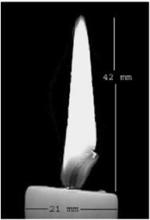 |
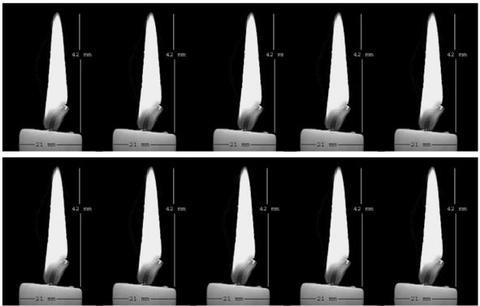 |
|
HRR: ~ 80 W Temperature:
|
HRR: ~ 800 W |
Heat Transfer
Heat transfer is a major factor in the ignition, growth, spread, decay and extinction of a fire. It is important to note that heat is always transferred from the hotter object to the cooler object - heat energy transferred to and object increases the object's temperature, and heat energy transferred from and object decreases the object's temperature.
CONDUCTION
Conduction is heat transfer within solids or between contacting solids.
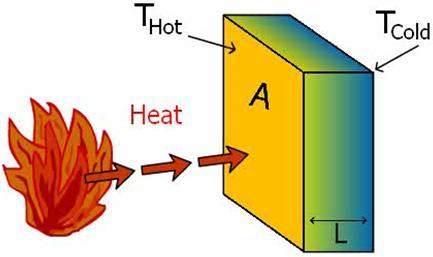
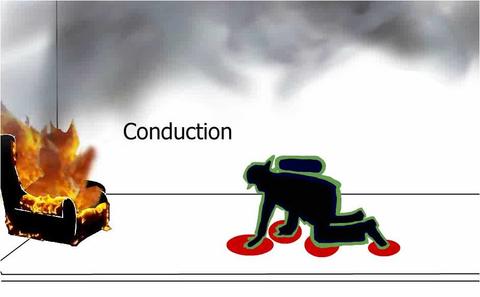
The governing equation for heat transfer by conduction is:

Where T is temperature (in Kelvin), A is the exposure area (meters squared), L is the depth of the solid (meters), and k is a constant that unique for different materials know as the thermal conductivity and has units of (Watts/meters*Kelvin).
Thermal Conductivity of Common Materials
Copper = 387 |
Gypsum = 0.48 |
Steel = 45.8 |
Oak = 0.17 |
Glass = 0.76 |
Pine = 0.14 |
Brick = 0.69 |
PPE = 0.034 - 0.136 |
Water = 0.58 |
Air = 0.026 |
CONVECTION
Convection is heat transfer by the movement of liquids or gasses.
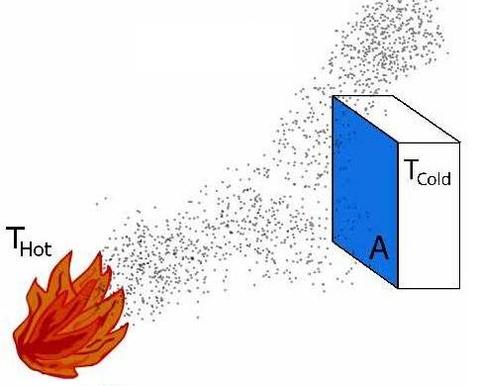
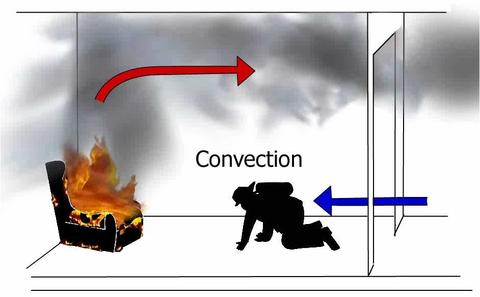
The governing equation for heat transfer by convection is:
Where T is temperature (in Kelvin), A is the area of exposure (in meters squared), and h is a constant that is unique for different materials known as the convective heat transfer coefficient, with units of W/m2*K. These values are found empirically, or, by experiment. For free convection, values usually range between 5 and 25. But for forced convection, values can range anywhere from 10 to 500.
RADIATION
Radiation is heat transfer by electromagnetic waves.
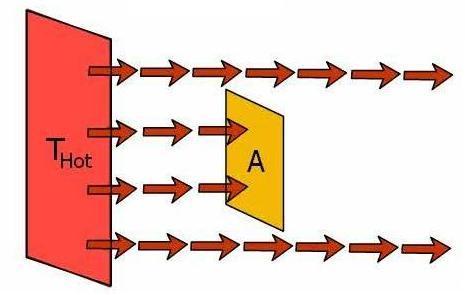
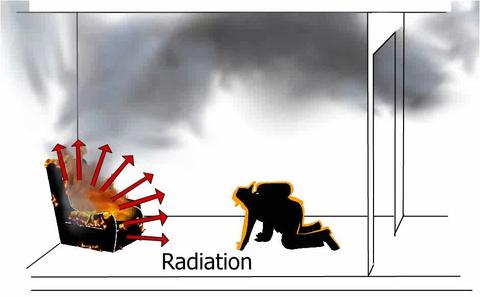
The governing equation for heat transfer by radiation is:

Where T is temperature (in Kelvin), A is the area of exposure (in meters squared), α is the thermal diffusivity (a measure of how quickly a material will adjust it's temperature to the surroundings, in meters squared per second) and ε is the emissivity (a measure of the ability of a materials surface to emit energy by radiation).
Fire Phenomena
Fire Development is a function of many factors including: fuel properties, fuel quantity, ventilation (natural or mechanical), compartment geometry (volume and ceiling height), location of fire, and ambient conditions (temperature, wind, etc).
|
Traditional Fire Development |
|
WatchWindows: Traditional Fire Development in a Compartment Fire |
|
Fire Behavior in a Structure |
|
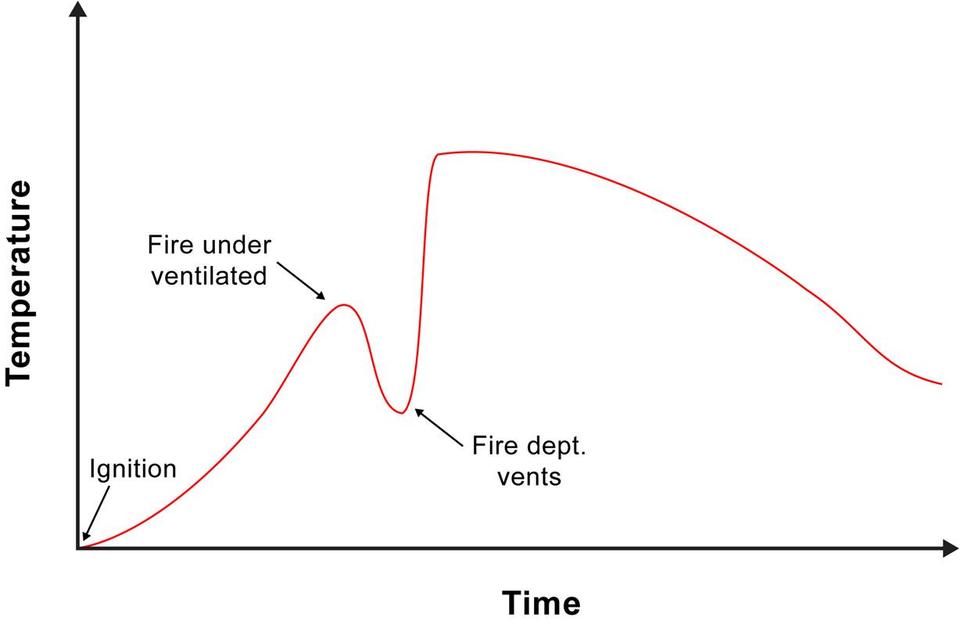 WatchWindows: Fire Behavior in a Structure (Ventilation limited) |
Flashover is the transition phase in the development of a contained fire in which surfaces exposed to the thermal radiation, from fire gases in excess of 600° C, reach ignition temperature more or less simultaneously and fire spreads rapidly through the space. This is the most dangerous stage of fire development.
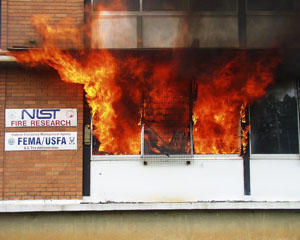
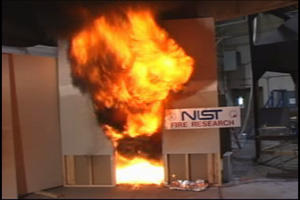
Videos:
Reports:


